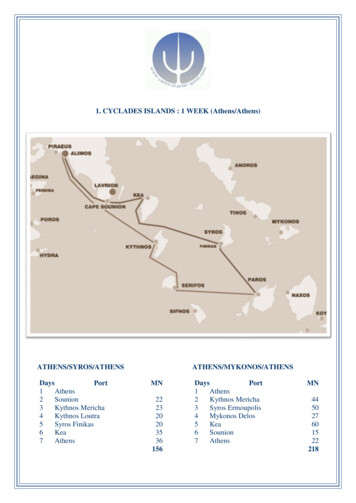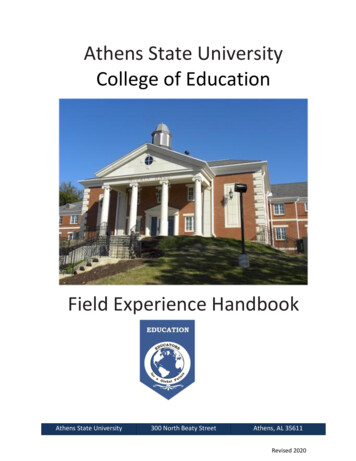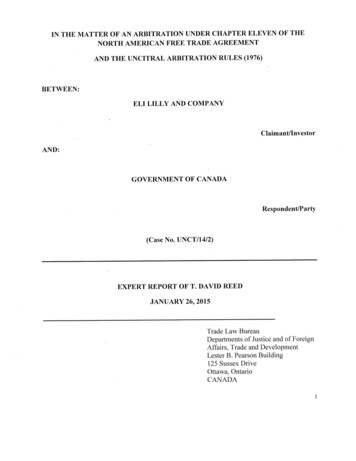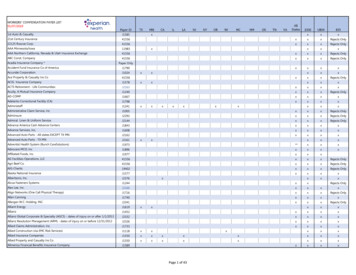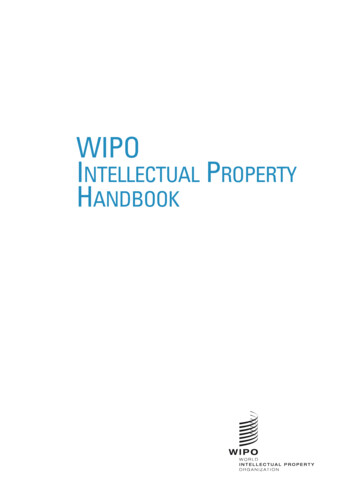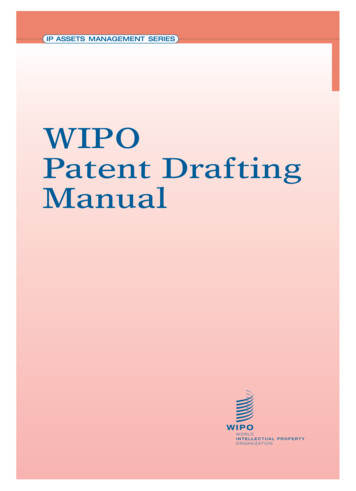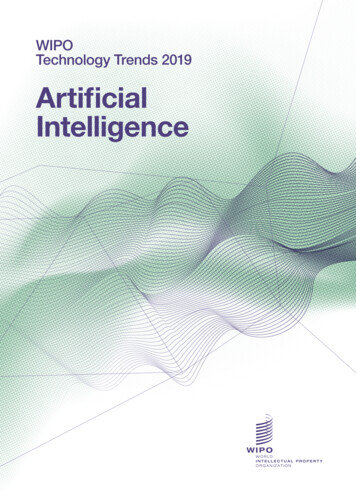
Transcription
https://en.wikipedia.org/wiki/The School of Athens
Patents in Science and Business: Challengesfaced by Applicants and The ScientificCommunityRoving Seminars: WIPO Services and InitiativesHellenic Industrial Property Organization (ΟΒΙ) Thessalonica, GreeceApril 11, 2019Speaker:Thomas Henninger, Senior Legal Information Officer,PCT Legal and User Relations Division, WIPO
Interest in Technology TransferASTPProton – Knowledge Transfer Europe: Koen Verhoef“That is what knowledge transfer is all about, ultimately:maximizing the chances that the results or academicendeavor find application in society”.European Knowledge Transfer ASTP-Proton Survey 2016:12,394 Invention Disclosures1,814 Patents granted (30% licensed)4,598 Start-ups created – 635 Spin-offs created 0,55 billion revenue from IP ( 43 million spent on IP) – 1.26billion Collaborative Research AgreementsAUTM: AUTM 2017 Licensing Activity Survey:US 3 billion patent licensing revenue (1,080 start-ups)
PCT filings by Universities worldwideUniversities intensified PCT involvementUniversity share is still very low
PCT Filings by Universes in RespectiveCountries
PCT Filings by PROs
USPTO patents owned by universities Bayh-DoleAct Notes: Patents were identified as university owned based on the name of the first assignee. Data: USPTO official data from univ/asgn/table 1 2012.htm Source: Martínez, Catalina and Valerio Sterzi, 2018. University patenting and the quest for technology transfer policy models inEurope, chapter in Varga A. and Erdos K. (Eds.), Handbook of Universities and Regional Development, Edward Elgar (forthcoming)
European IP ownership regimesPolicy and legal 0200220022003Finland2007Stronger enforcement ofinstitutional ownership systemalready in placeUnited 861999199119971998Introduction of Professor’sprivilegeItaly2001Continuation of the Professor’sprivilegeSweden1949Abolishment of the Professor’sprivilege, to increase scientists’incentives to disclose inventionsto universities Source: Martínez, Catalina and Valerio Sterzi, 2018. University patenting and the quest for technology transfer policymodels in Europe, chapter in Varga A. and Erdos K. (Eds.), Handbook of Universities and Regional Development,Edward Elgar (forthcoming)
There is no Model that Fits All !Variety of existing models: “American” – strong position on institutional IPownership, licensing; UK ; “French” – Regional Centers; IP Hubs – ASEAN Region; “Professor's Privilege” and “Creation for Users” –Sweden; Australian Technology Network – Harmonized IPPolicies for easier commercialization; Intel Science and Technology Centers (ISTCs) –Open Source.
University/PRO applications in Greece2009-2018FOUNDATION OF RESEARCH AND TECHNOLOGY HELLAS/FORTH131.46% Total 4.4%UNIVERSITY OF PATRAS101.13%NATIONAL CENTRE FOR SCIENTIFIC RESEARCHDEMOKRITOS (NCSR DEMOKRITOS)50.56%NATIONAL HELLENIC RESEARCH FOUNDATION30.34%NATIONAL AND KAPODESTRIAN UNIVERSITY OFATHENS30.34%BIOMEDICAL RESEARCH FOUNDATION OF THEACADEMY OF ATHENS30.34%UNIVERSITY OF CRETE10.12%
What are the challenges faced byuniversities in the patent system?Freedom to operate and research exceptionScientific publication (copyright, public domain andpublic accessability) vs. patenting (protection)Funding for patenting (fees) and technology transferPatents (and exclusive vs. non-exclusive licenses)Licensing to industry vs. university spin-offs/start upsAdvantages of patents:Set the boundaries of the invention in the claimsHelp creating markets for technologyMake invention more visible to patent examiners inother jurisdictions, to prevent others from patentingacademic prior art
Tools for Universities to getpatent protection abroad
Seeking patents multinationally today Paris system vs. PCT nsabroad12File localapplication177 StatesInternationalpublication(months)PCT19780File localapplicationEnternationalphase12File PCTapplication16Internationalsearch report &written opinion1822(optional)demand Internationalpreliminaryreport onpatentability30152 States
Paris route vs. PCT national phase“Market share”Non-resident PCT national phase -resident direct .0Share of non-resident PCT National phase entries in total non-resident applications 2004 2005Year200620072008200920102011201220132014
PCT Testimonial: InventorProfessor Shuji Nakamura—co-winner ofthe 2014 Nobel Prize for Physics for hiswork on blue LED technology—is quotedin a December 2014 WIPO Magazinearticle:“ The PCT is critical for these early stagetechnologies because it gives us the opportunity toprotect our patents globally while allowing the marketand the technology to mature further beforedetermining which countries might be most valuableto commercial partners.”
PCT Success: Greek InventorEpi-LASIK (Laser assisted in situ keratomileusis) Ophthalmolog Ioannis Pallikaris Rector at the University of Crete Founder and Director of The Institute ofVision and Optics Medical Advisory Board Chair for companyPresbia So far 13 PCT applications as applicant,co-applicant or inventor Use of the PCT system for technologytransfer and businessPCT/IB2002/002758Source Patentscope; Wikipedia.
Certain PCT AdvantagesThe PCT, as the cornerstone of the international patent system,provides a worldwide system for simplified filing and processingof patent applications, which—1. postpones the major costs associated with internationalizing apatent application2. provides a strong basis for patenting decisions3. harmonizes formal requirements4. protects applicant from certain inadvertent errors5. evolves to meet user needs6. is used by the world’s major corporations, universities andresearch institutions when they seek multinational patentprotection
152 PCT States PCTAlbaniaAlgeriaAngolaAntigua and badosBelarusBelgiumBelizeBeninBosnia and HerzegovinaBotswanaBrazilBrunei DarussalamBulgariaBurkina FasoCambodia (8 Dec. ‘16)CameroonCanadaCentral African RepublicChadChileChinaColombiaComorosCongoCosta RicaCôte d'IvoireCroatiaCubaCyprusCzech RepublicDemocratic People'sRepublic of KoreaDenmarkDjibouti (23 Sept. ‘16)DominicaDominican RepublicEcuadorEgyptEl SalvadorEquatorial ndurasHungaryIcelandIndiaIndonesiaIran (Islamic Republic of)IrelandIsraelItalyJapanJordan (9 June 17)KazakhstanKenyaKuwait (9 Sept. ‘16)KyrgyzstanLao People’s Dem Rep.LatviaLesothoLiberiaLibyan Arab New ZealandNicaraguaNigerNigeriaNorwayOmanPanamaPapua New GuineaPeruPhilippinesPolandPortugalQatarRepublic of KoreaRepublic of MoldovaRomaniaRwandaRussian FederationSaint LuciaSaint Vincent andthe GrenadinesSan MarinoSao Tomé e PrincipeSaudi ArabiaSenegalSerbiaSeychellesSierra LeoneSingaporeSlovakiaSloveniaSouth AfricaSpainSri LankaSudanSwazilandRecent accessions:JordanKuwaitDjiboutiCambodiaSt. Kitts and NevisSwedenSwitzerlandSyrian Arab RepublicTajikistanThailandThe former YugoslavRepublic of MacedoniaTogoTrinidad and TobagoTunisiaTurkeyTurkmenistanUgandaUkraineUnited Arab EmiratesUnited KingdomUnited Republic of TanzaniaUnited States of AmericaUzbekistanViet NamZambiaZimbabwe
PCT 868890929496982018: 253,000 applications ( 3.9 %)00020406081012141618
Top Ten GR PCT users 2017Applicant’s name2017applicationsBIC-VIOLEX SA10PHARMATHEN S.A.8APIVITA SA3KARATZIS S.A. INDUSTRIAL & HOTELIERENTERPRISESRONTIS HELLAS S.A.3NATIONAL HELLENIC RESEARCH FOUNDATION2UNIVERSITY OF PATRAS2ALUMINCO A.E.1ARISTOTLE UNIVERSITY OF THESSALONIKI - E.L.K.E.1BIOMEDICAL RESEARCH FOUNDATION OF THEACADEMY OF ATHENS13Many different applicants; mainly SME and also by universities andpublic research tics/country profile/profile.jsp?code GR
Future Direction of the PCT--accessibility of system-Making PCT accessible to applicants of all types from allContracting States Currently: 90% fee reduction for individual inventors from certainStates, including Greece Future development? Fee reductions (SMEs, universities, research institutes, individualapplicants)BR proposal
WIPO: University and IP Program
IP Policy – Real NecessityIncreasing IP activity in academic institutions;There is a huge number of IP commercialization trends – yourinstitution needs to define its best suitable solution;Markets are moving – you are concerned!Cross – boarder research collaborations – there are multipletechnology transfer Projects within the EU;Foreign funding for contractual research – you need to agree onleading principles, in particular concerning IP ownership andcommercialization rules;Expectations huge from society – IP Policy should create favorable,transparent conditions for academic institutions to respond to thoseexpectations;Researchers need to be consulted and aware!!
Examples of IP Policy TrendsOpenness of Science – access to information andcollaborative work with industry and society;Live Laboratories;Socially responsible IP Commercialization of researchresults;Creation of partnerships and collaborations;Involvement of industry partners in definition of researchprograms – in order to increase their funding of science;Increasing number of start ups (creation of high profilejobs);Better use of know how – one of the biggest assets ofAcademy.
PCT Resources/InformationFor general questions about the PCT, contact the PCTInformation Service at:Telephone: 41-22 338 83 38Facsimile: 41-22 338 83 39E-mail: pct.infoline@wipo.intthomas.henninger@wipo.int ( 41 22 338 84 29)
Epi-LASIK (Laser assisted in situ keratomileusis) Source Patentscope; Wikipedia. Ophthalmolog Ioannis Pallikaris Rector at the University of Crete Founder and Director of The Institute of Vision and Optics Medical Advisory Board Chair for company Presbia So far 13 PCT applications as applicant, co-applicant or inventor


